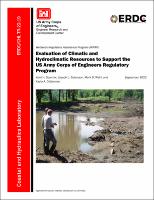Please use this identifier to cite or link to this item:
https://hdl.handle.net/11681/45484Full metadata record
| DC Field | Value | Language |
|---|---|---|
| dc.contributor.author | Sparrow, Kent H. | - |
| dc.contributor.author | Gutenson, Joseph L. | - |
| dc.contributor.author | Wahl, Mark D. | - |
| dc.contributor.author | Cotterman, Kayla A. | - |
| dc.creator | Coastal and Hydraulics Laboratory (U.S.) | - |
| dc.date.accessioned | 2022-09-21T19:09:27Z | - |
| dc.date.available | 2022-09-21T19:09:27Z | - |
| dc.date.issued | 2022-09 | - |
| dc.identifier.govdoc | ERDC/CHL TR-22-19 | - |
| dc.identifier.uri | https://hdl.handle.net/11681/45484 | - |
| dc.identifier.uri | http://dx.doi.org/10.21079/11681/45484 | - |
| dc.description | Technical Report | en_US |
| dc.description.abstract | Short-term climatic and hydrologic interactions, or hydroclimatology, are an important consideration when delineating the geographic extent of aquatic resources and assessing whether an aquatic resource is a jurisdictional water of the United States (WOTUS) and is therefore subject to the Clean Water Act (CWA). The now vacated 2020 Navigable Waters Protection Rule (NWPR) required the evaluation of precipitation and other hydroclimatic conditions to assess the jurisdictional status of an aquatic resource based on normal hydroclimatic conditions. Short-term hydroclimatic conditions, such as antecedent precipitation, evapotranspiration, wetland delineation, and streamflow duration assessments, provide information on an aquatic resource’s geo-graphic extent, hydrologic characteristics, and hydrologic connectivity with other aquatic resources. Here, researchers from the US Army Corps of Engineers, Engineer Research and Development Center (ERDC) evaluate tools and data available to practitioners for assessing short-term hydroclimatic conditions. The work highlights specific meteorological phenomena that are important to consider when assessing short-term hydroclimatic conditions that affect the geographic extent and hydrologic characteristics of an aquatic resource. The findings suggest that practitioners need access to data and tools that more holistically consider the impact of short-term antecedent hydroclimatology on the entire hydrologic cycle, rather than tools based solely on precipitation. | en_US |
| dc.description.sponsorship | Wetlands Regulatory Assistance Program (U.S.) | en_US |
| dc.description.tableofcontents | Abstract .......................................................................................................................................................... ii Figures and Tables ......................................................................................................................................... v Preface ........................................................................................................................................................... xi 1 Introduction ............................................................................................................................................ 1 1.1 Background ..................................................................................................................... 1 1.2 Objectives ........................................................................................................................ 3 1.3 Approach ......................................................................................................................... 3 2 Survey of Existing Tools and Data to Support Typical Year Evaluation ...................................... 6 2.1 USGS WaterWatch .......................................................................................................... 7 2.2 NOAA Stage-IV rainfall .................................................................................................... 8 2.3 National Water Model (NWM) ........................................................................................ 9 2.4 Streamflow Prediction Tool (SPT) ................................................................................. 11 2.5 Snow Data Assimilation System (SNODAS) ................................................................. 12 2.6 The United States Drought Monitor (USDM) ............................................................... 14 2.7 Climate Prediction Center (CPC) .................................................................................. 15 2.8 Parameter-elevation Regressions on Independent Slopes Model (PRISM)............... 17 2.9 Gridded Surface Meteorological (gridMET) ................................................................. 18 3 Meteorological Phenomena to Consider When Assessing Climatological and Hydrological Normalcy ....................................................................................................................... 20 3.1 The North American Monsoon ..................................................................................... 20 3.2 Lake effect snow ........................................................................................................... 21 3.3 Nor’easters .................................................................................................................... 23 3.4 Snowpack melt ............................................................................................................. 24 4 Assessing the Capacity of the Antecedent Precipitation Tool (APT) for Approximating Daily Streamflow Conditions ................................................................................ 26 4.1 APT, Palmer Drought Severity Index (PDSI), and USGS gage comparison ................. 26 4.2 APT antecedent precipitation score, PDSI accuracy, and watershed size ................. 29 4.3 Hydrologic Unit Code (HUC) analysis ........................................................................... 31 4.3.1 HUC 01–New England ..................................................................................... 34 4.3.2 HUC 02–Mid-Atlantic ....................................................................................... 35 4.3.3 HUC 03–South Atlantic-Gulf ............................................................................ 37 4.3.4 HUC 04–Great Lakes ....................................................................................... 38 4.3.5 HUC 05–Ohio ................................................................................................... 40 4.3.6 HUC 06–Tennessee ......................................................................................... 41 4.3.7 HUC 07–Upper Mississippi .............................................................................. 43 4.3.8 HUC 08–Lower Mississippi .............................................................................. 44 4.3.9 HUC 09–Souris-Red-Rainy ............................................................................... 46 4.3.10 HUC 10–Missouri ............................................................................................. 47 4.3.11 HUC 11–Arkansas-White-Red .......................................................................... 49 4.3.12 HUC 12–Texas-Gulf .......................................................................................... 50 4.3.13 HUC 13–Rio Grande ........................................................................................ 52 4.3.14 HUC 14–Upper Colorado ................................................................................. 53 4.3.15 HUC 15–Lower Colorado ................................................................................. 55 4.3.16 HUC 16–Great Basin ....................................................................................... 56 4.3.17 HUC 17–Pacific Northwest .............................................................................. 58 4.3.18 HUC 18–California ........................................................................................... 59 4.3.19 HUC 19–Alaska ................................................................................................ 61 4.3.20 HUC 20–Hawaii ................................................................................................ 62 4.3.21 HUC 21–Caribbean .......................................................................................... 63 5 Summary ............................................................................................................................................... 65 6 Recommendations .............................................................................................................................. 70 References ................................................................................................................................................... 73 Appendix: USGS Gages Used in the Analysis ........................................................................................ 79 Abbreviations ............................................................................................................................................... 85 Report Documentation Page .................................................................................................................... 87 | - |
| dc.format.extent | 101 pages / 9.85 MB | - |
| dc.format.medium | - | |
| dc.language.iso | en_US | en_US |
| dc.publisher | Engineer Research and Development Center (U.S.) | en_US |
| dc.relation.ispartofseries | Technical Report (Engineer Research and Development Center (U.S.)) ; no. ERDC/CHL TR-22-19 | - |
| dc.rights | Approved for Public Release; Distribution is Unlimited | - |
| dc.source | This Digital Resource was created in Microsoft Word and Adobe Acrobat | - |
| dc.subject | Aquatic resources | en_US |
| dc.subject | Climatology | en_US |
| dc.subject | Hydrology | en_US |
| dc.subject | Water--Law and legislation--United States | en_US |
| dc.subject | Wetlands | en_US |
| dc.title | Evaluation of climatic and hydroclimatic resources to support the US Army Corps of Engineers Regulatory Program | en_US |
| dc.type | Report | en_US |
| Appears in Collections: | Technical Report | |
Files in This Item:
| File | Description | Size | Format | |
|---|---|---|---|---|
| ERDC-CHL TR-22-19.pdf | 9.85 MB | Adobe PDF |  View/Open |